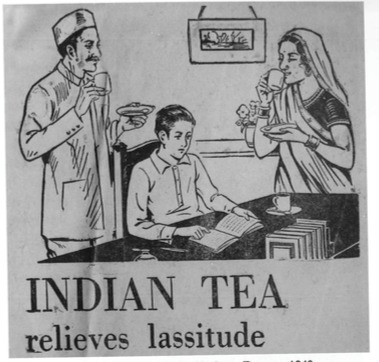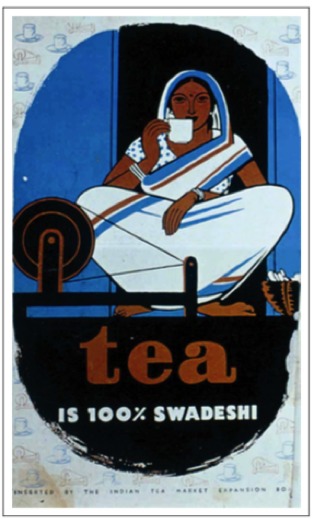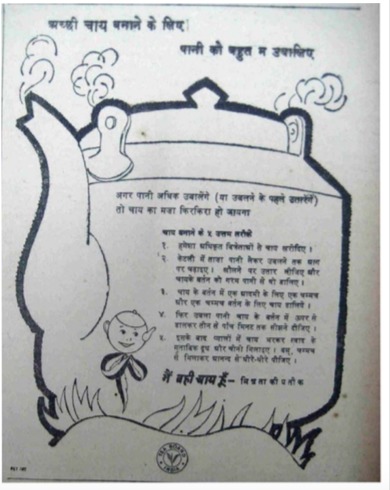Advertisements for Chai in India
If you visit India today, you will probably notice that chai is a deeply ingrained part of daily culture. It seems so prolific and natural that you might imagine a long history of Indians drinking and producing tea. However, as recently as the early 1900s, most Indians did not even know how to brew a cup of tea. It was originally only popular among British colonists, who started its cultivation, and the upper class Indians who followed British lifestyles. A robust advertising campaign occurred across India in the early 20th century, especially around the time of Indian independence in 1947. Tea was advertised as being ‘Indian,’ so that people would feel pride in drinking it without associating it with its colonial origins. However, ads often still perpetuated Western ideals of behavior that tea could bring – alertness, energy, and sophistication.
(Image 1) This image is an advertisement from the 1940s in an Indian newspaper that shows a man, woman, and a boy in a house drinking tea. This advertisement promotes the positive benefits of tea, and also encourages western ideals, like being energetic, familial, and studious. Though there were other advertisements of the time in Indian languages, there were also many in English, which reflects the fact that tea was being promoted to educated, upper class Indians. It is also important to note that this does not promote a specific brand of tea, just tea in general. Nearly all tea consumed in India was produced in India, and during the early 1940s this was still controlled by the British, so they had no need to promote a brand. Moreover, it promotes ‘Indian tea,’ which implies that the tea is made in India, and is distinct from other types of tea. This fits with the “Tea is 100% Swadeshi” image, as tea being ‘Indian’ was one of the main ways to encourage people to drink it. Though this advertisement is in English, it was also common for advertisements of this time to be in Hindi or Bengali (as you can see with the Bengali newspaper ad). Other advertisements from the time, like the ‘Tea Fights Fatigue’ ad, promote its energetic qualities, which were helpful to laborers as well as white-collar workers.
(Image 2) This is an advertisement from 1947, that features an Indian woman sitting in front of a spinning wheel drinking tea. “Swadeshi” means ‘of the country,’ or ‘indegenous,’ so this advertisement is clearly trying to promote tea as an Indian drink, not a foreign or British one (Lutgendorf 2012, 19). The spinning wheel is also significant; this is reminiscent of Ghandi’s campaign for people to produce their own fabric and clothes, instead of relying on outside powers. This ad tries to make tea the same democratic sort of drink; by drinking it, you are supporting Indians. There is an egalitarian aspect to tea in that it appeals to nearly every person in an extremely diverse and divided country. During a time when people of different religions and different classes and castes needed to unite to make one ‘India’ in the face of British imperialism, this unity was paramount. This ad is very representative of the promotion of tea in India as a ‘native’ drink, and the indigenization of it. That is, Indians took over the production and consumption following partition and independence in the middle of the 20th century. Now, India is the world’s largest producer and consumer of tea (Collingham, 2006).
(Image 3) This is an ad from a bit later, in 1953, in a newspaper in Calcutta. There is a little cartoon, made up of tea leaves and a teapot, saying 'I am Chai' as well as instructions for preparing chai. The instructions are in Bangla, the language most commonly spoken in Calcutta, to appeal to the local population and teach them the ways of making their own tea.
(Image 4) This poster is another example of the campaign during the 1940s to expand tea consumption in India. Like the "Tea Relieves Lassitude" advertisement, this poster promotes the ideals of energy and alertness that tea brings, but also shows an Indian woman.




